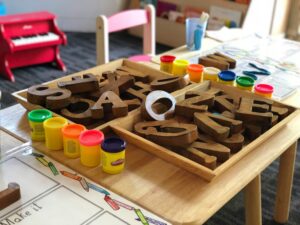
Back to school. Happy child is sitting at desk. Girl with teacher in classroom.
As a teacher, you must look for innovative methods, tools, ideas, and resources to engage your students better. The way you engage with your students matters a lot because it will determine whether or not learning is taking place.
Here are five resources to help keep your students ready to learn, engaged, and captivated.
Make learning more visual
What students see stick better at their memories than what they read. Visuals also grab their attention and make them more active. You can take advantage of this by including more visual elements in your teaching.
For example, when teaching English, you can let students create word art using nouns, verbs, vocabularies, or any group of words to help them learn English.
Creating word art doesn’t require expensive resources. Markers and some pieces of paper or cardboard will do. If you want to go digital, you can use WordItOut or WordCloud, or other word cloud creators you can come across.
Once the word clouds are ready, you can build on the students’ learning potential by having each student post their work on a classroom gallery. Let students discuss the terms displayed in the gallery by translating or defining them and even brainstorming new ideas. You can adapt visual learning to any subject you are teaching.
Just use music
If you’ve never used music as a teaching/learning tool, you’ve missed a lot. Some teachers play music to their students as they enter the classroom or when they feel exhausted. Music rejuvenates and can also pass important messages to students. Music also stirs emotions and can be useful in boosting your students’ mood.
Apart from that, some experts have also created songs that teach particular topics. For example, you may find a song on geographical features/information, vocabulary/rhymes, or famous people in history.
Some teachers even encourage students to create their songs. You can do the same, and record these songs using Recap or Flipgrip, and replay them in class.
Students find music to be a more authentic and meaningful way of learning, helping them retain the knowledge gained.
Make learning a game
There is no better way you can engage your students that involving them in learning games. Having them play games is a fun and exciting way to help them recall facts. By using games in teaching, you’ll move moves your students from being consumers to creators. Games provide them with an opportunity to engage in a way that’s more personalized and authentic.
Games are essential learning resources because they are entertaining and make the students think critically if the games are more challenging.
Some digital like Triventy, Quizizz, Quizlet, and Kahoot are great for creating classroom games. They help students to develop critical thinking, collaboration skills, and creativity.
Classroom games are also another way of enhancing comfort and communication among the students.
Online Collaborative Tools
Technology now makes it possible to engage students both within and without the classrooms. If you and your students have an internet connection, you can use the several online tools available to teach, give assignments, and even send feedback.
There are also online resources for teachers specifically to help train in how to better communicate with students that you can use to help build better relationships with the students you teach. For example, there is empathy training for teachers that you can take online to help with teaching in the classroom.
For example, using an online tool like Padlet, you can create a brainstorming session and invite your student to participate in the discussion.
Other online tools that can enhance your engagement with students include TodaysMeet, Socrative, Twilda, Collaborize Classroom, and Scribblar, to name just a few.
Team-Building Ice Breakers
Whatever the level of your students, team-building ice breakers and games are the best ways to keep them engaged. For example, there are many ways you can have your students occupied with ice breakers. Whether you are using digital tools or simple items like pencil and paper, ice breakers work magic. They encourage team-building and are also a fun way to learn.
Canva, Piktochart, Buncee, and other such digital tools are great icebreakers. They can help students make connections with one another and find their common interests. This way, students appreciate the diverse backgrounds and perspectives the other students contribute to the learning environment.
Final Words
As a teacher, you might have faced a situation where it becomes an uphill task to teach specific topics. By using the resources discussed above, you can make these topics to be more fun and engaging.
As you can see, some of these resources don’t cost much, because they are available locally. Do a lot of research and find other ways to keep your students engaged both in class and home.

